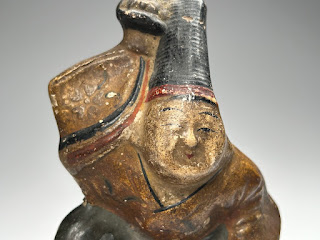三番叟を舞う人物 Sanbaso Dancers
左(小さい方): 高さ 7.2 cm、幅 5.8 cm
どちらも三番叟(さんばそう・さんばんそう)を舞う人物をかたどった古人形。大きい方は左手に扇、右手に鈴を持った男が舞のさなかに片足をあげた瞬間を見事に描写している。お顔立ちや着物の柄、そして山形県立博物館の民俗データベースにほぼ同じ意匠の人形(資料番号 6H003857)が掲載されていることなどからして、山形県米沢市でつくられた相良人形にまちがいない。たいへんていねいなつくりで、江戸後期の上手作とおもう。小さい方は買ったときの話では岩手県の花巻人形ということだった。ちょっとポーズは違うが、やはり右手に鈴をもっている。地元花巻ではこの手の小型の土人形を「まめっこ人形」と呼び、子どもの玩具としたようだ。「まめっこ」は赤色のものが多く、厄除け・魔除けの意味合いがあるという(菊池正樹「花巻人形の愉しみ」花巻人形工房、2019年)。
三番叟を題材とした土人形は他の産地でもつくられている。三番叟とは神前もしくはそれに準ずる神聖な場で披露される天下泰平、子孫繁栄、五穀豊穣を祈る祝いの舞であり、それをかたどった人形は子どもたちのすこやかな成長を願う親たちにとっての縁起物として人気があったのだろう。
Both clay dolls mimic a dancer of Sanbaso, a traditional dance performed at a Noh stage or Japanese Shinto shrine for everyone's well-being. The large one is an old Sagara doll, Yonezawa, Yamagata. It depicts a moment when the dancer raised his knee with a fan on the left hand and bells on the right hand. I think it is a well-made clay doll in the early 19th century. The smaller one is probably a Hanamaki doll, Iwate. The pose is a little different, but this dancer also holds similar bells. The local people in Hanamaki called this kind of small clay doll a mamekko (tiny) doll, which was a kid's toy and usually colored red for preventing evil.
Sanbaso was a popular motif of Japanese old clay dolls. People wanted Sanbaso dolls and prayed for children's health and growth.



